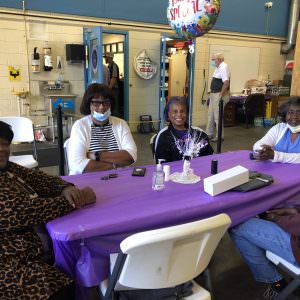Transportation Appreciation Week
Any school district, no matter the size, could be accurately compared to a complex machine such as a computer, smartphone, or, for the purposes of this story, a school bus.
When the general public sees any of these machines, they only see the final result – the outside appearance and what that machine can do for them. What’s hidden, however, are the most important parts of that machine and what allows it to be used by the public. A school district is the same way – the hidden parts are often the most important.
When one thinks of schools and districts, the obvious people are at the forefront – students, teachers, and principals. But those students have to be able to get to schools to learn and parents have to work, so it’s left to school bus drivers (the mostly hidden part of the district) to do the essential and tedious work of driving students to and from school nearly every weekday from August to May.
 Last week, Haywood County Schools (HCS) honored their bus drivers and monitors and transportation staff by having a cookout recognizing the oftentimes overlooked work they do on a daily basis.
Last week, Haywood County Schools (HCS) honored their bus drivers and monitors and transportation staff by having a cookout recognizing the oftentimes overlooked work they do on a daily basis.
Transportation Director, Jeremiah Cavitt, understands the importance of the bus drivers of HCS, and not simply for the purposes of driving students to school.
 “Our bus drivers are a vital part of our schools,” he explained. “They are the first contact for a lot of our students at the beginning of a school day. Our drivers keep that in mind. They greet each student in the morning; they allow the students to unwind at the end of the day. Our drivers and monitors really are the bookends for a student’s day at school.”
“Our bus drivers are a vital part of our schools,” he explained. “They are the first contact for a lot of our students at the beginning of a school day. Our drivers keep that in mind. They greet each student in the morning; they allow the students to unwind at the end of the day. Our drivers and monitors really are the bookends for a student’s day at school.”
While a bus driver’s job is challenging enough transporting students to and from school daily, most bus drivers also have to deal with behavioral issues, too. In Haywood County, however, nearly all busses also have monitors aboard the bus to help handle any situation that arises during a bus route.
“We use the bus as a classroom extension – behavioral expectations in the classroom should match behavioral expectations on the bus,” Cavitt explained. “Our monitors are there, first of all, to build relationships with the students. But they’re also available should they be needed for assistance for any issue on the bus, not only disciplinary issues.”
School bus monitors add an extra layer of support for the bus drivers whose primary responsibility is the actual transport of students to and from school.
There are thirty-two bus drivers in Haywood County. Most of these drivers have to run double routes most days. Their day begins at 6:00 AM for morning pickup, then continues from 2:45 to 4:30 for afternoon drop-off. Some drivers also assist with transportation for 21st Century (Haywood County Schools’ after school program), and those drivers will end their day around 7:00 PM.
“Our busses are running by 6:00 AM. They pull back in around 7:30 or 8:00 AM. We want all our drivers here by 6:00 AM so we know who’s available that day. Afternoon routes start at 2:30. We have two city busses per school and our county busses run all schools then take their territory,” Jeremiah explained.
The logistics of bus routes and availability can sometimes feel complex, but Jeremiah understands the importance of the bus drivers in HES goes far beyond picking up and dropping off students or making a route schedule.
“We try to create relationships built between the driver and monitor and the students. We want to allow the students to be kids but also provide some boundaries for behavior on the bus, and that’s all centered around building relationships that start the day in a positive way and end the day in a positive way for the students,” Cavitt said. “Our drivers and monitors do an excellent job of that.”
Transportation departments in every district are both essential and too often overlooked. Let’s all take a moment and recognize the importance, necessity, and extra support for students that is provided by the transportation department in Haywood County.




